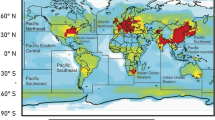Abstract
In this study, the concentrations of Cd and Hg were measured in muscle of juvenile individuals at an importan fishing ground in southeastern Gulf of California to assess the health risk to human consumers considering elemental levels and rate of shark consumption in NW Mexico. Twenty-eight individuals were sampled in September 2019. Quantification of Hg was made by cold vapor-atomic absorption spectrophotometry, analyses of Cd were made by graphite furnace atomic absorption spectrophotometry. In general, average Hg (1.27 µg g−1 dry weight) concentrations were higher than Cd (0.059). In comparison to results of Cd and Hg in muscle of several species of genus Rhizoprionodon sp., our reported concentrations were comparable. Maximum permissible limits (Cd 0.5 and Hg 0.5 µg g−1 wet weight) in fish products for human consumption were not exceeded. Health risk assessment to shark consumers indicated that Hg is of more concern than Cd but no hazards exist.

Similar content being viewed by others
References
Adams DH, McMichael RH (1999) Mercury levels in four species of sharks from the Atlantic coast of Florida. Fish Bull 97:372–379
Adel M, Mohammadmoradi K, Ley-Quiñonez CP (2017) Trace element concentrations in muscle tissue of milk shark, (Rhizoprionodon acutus) from the Persian Gulf. Environ Sci Pollut Res 6:5933–5937
Alatorre-Ramírez VG, Galván-Magaña F, Torres-Rojas YE (2013) Trophic habitat of the Pacific sharpnose shark, Rhizoprionodon longurio, in the Mexican Pacific. J Mar Biol Assoc UK 93(8):2217–2224
Ali H, Khan E (2018) Trophic transfer, bioaccumulation, and biomagnification of nonessential hazardous heavy metals and metalloids in food chains/ webs-Concepts and implications for wildlife and human health. Hum Ecol Risk Assess 25(6):1353–1376
Al-Reasi HA, Ababneh FA, Lean DR (2007) Evaluating mercury biomagnification in fish from a tropical marine environment using stable isotopes (δ13C and δ15N). Environ Toxicol Chem 26(8):1572–1581
Amezcua F, RuelasInzunza J, Coiraton C, SpanopoulosZarco P, PáezOsuna F (2022) A global review of cadmium, mercury, and selenium in sharks: geographical patterns, baseline levels and human health implications. Rev Environ Contam Toxicol 260:4
Amorim-Lopes C, Willmer IQ, Araujo NLF, Pereira LH, Monteiro F, Rocha CC, Saint’Pierre TD, dos Santos LN, Siciliano S, Vianna M, Hauser-Davis RA (2020) Mercury screening in highly consumed sharpnose sharks (Rhizoprionodon lalandii and R. porosus) caught artisanally in southeastern Brazil. Elem Sci Anth 8(1):022.Boldrocchi G, Monticelli D, MoussaOmar Y, Bettinetti R (2019) Trace elements and POPs in two comercial shark species from Djibouti: Implications for human exposure. Sci Tot Environ 669:637–648
CONAPESCA (2017) Anuario Estadístico de Acuacultura y Pesca. Secretaría de Agricultura, Ganadería y Desarrollo Rural, Pesca y Alimentacóon. Comisión Nacional de Pesca. https://www.gob.mx/conapesca/documentos/anuario-estadistico-deacuacultura-y-pesca
Denton G, Breck W (1981) Mercury in tropical marine organisms form North Queensland. Mar Pollut Bull 12(4):116–121
Fischer W, Krupp F, Schneider W, Sommer C, Carpenter KE (1995) Guía FAO para la identificación de especies para los fines de la pesca. Pacífico centro-oriental. FAO, Rome
Fisk AT, Tittlemier SA, Pranschke JL, Norstrom RJ (2002) Using anthropogenic contaminants and stable isotopes to assess the feeding ecology of Greenland shark. Ecology 83(8):2162–2172
Fistarol GO, Coutinho FH, Moreira AP, Venas T, Cánovas A, de Paula SE, Jr Coutinho R, de Moura RL, Valentin JL, Tenenbaum DR, Paranhos R, do Valle Rde A, Vicente AC, Amado Filho GM, Pereira RC, Kruger R, Rezende CE, Thompson CC, Salomon PS, Thompson FL, (2015) Environmental and sanitary conditions of Guanabara Bay, Rio de Janeiro. Front Microbiol 6:1232
Fréry N, Maury-Brachet R, Maillot E, Deheeger M, de Mérona B, Boudou A (2001) Gold-mining activities and mercury contamination of native amerindian communities in French Guiana: key role of fish in dietary uptake. Environ Health Persp 109(5):449–456
Frías-Espericueta MG, Cárdenas-Nava NG, Márquez-Farías JF, Osuna-López JI, Muy-Rangel MD, Rubio-Carrasco W, Voltolina D (2014) Cadmium. copper, lead and zinc concentrations in female and embryonic Pacific sharpnose shark (Rhizoprionodon longurio) tissues. Bull Environ Contam Toxicol 93:532–535
Frías-Espericueta MG, Ruelas-Inzunza J, Benítez-Lizárraga R, Escobar-Sánchez O, Osuna-Martínez C, Delgado-Álvarez CG, Aguilar-Juárez M, Osuna-López JI, Voltolina D (2019) Risk assessment of mercury in sharks (Rhizoprionodon longurio) caught in the coastal zone of Northwest Mexico. J Consum Prot Food Saf 14:349–354
Furlong-Estrada E, Tovar-Águila J, Pérez-Jiménez JC, Ríos-Jara E (2015) Resilience of Sphyrna lewini, Rhizoprionodon longurio, and Carcharhinus falciformis at the entrance to the Gulf of California after three decades of exploitation. C Mar 41(1):49–63
García-Hernández J, Cadena-Cárdenas L, Betancourt-Lozano M, García-De-La-Parra LM, García-Rico L, Márquez-Farías F (2007) Total mercury content found in edible tissues of top predator fish from the Gulf of California, Mexico. Toxicol Environ Chem 89:507–522
Gil-Manrique B, Nateras-Ramírez O, Martínez-Salcido AI (2017) Cadmium and lead concentrations in hepatic and muscle tissue of demersal fish from three lagoon systems (SE Gulf of California). Environ Sci Pollut Res 24(14):12927–12937
Hammerschlag N, Davis DA, Mondo K, Seely MS, Murch SJ, Glover WB, Divoll T, Evers DC, Mash DC (2016) Cyanobacterial neurotoxin BMAA and mercury in sharks. Toxins 8:238
Hurtado-Banda R, Gómez-Alvarez A, Márquez-Farías JF, Córdoba-Figueroa M, Navarro-García G, Medina-Juárez LA (2012) Total mercury in liver and muscle tissue of two coastal sharks from the Northwest of Mexico. Bull Environ Contam Toxicol 88:971–975
Lacerda LD, Paraquetti HHM, Marins RV, Rezende CE, Zalmon IR, Gomes MP, Farias V (2000) Mercury content in shark species from the South-Eastern Brazilian coast. Rev Bras Biol 60:571–576
Lyle JM (1986) Mercury and selenium concentrations in sharks from Northern Australian waters. Aust J Mar Fresh Res 37:309–321
Márquez-Farías JF, Corro-Espinosa D, Castillo-Géniz JL(2005) Observations on the biology of the Pacific sharpnose shark, Rhizoprionodon longurio (Jordan & Gilbert, 1882), captured in southern Sinaloa, México. J Northwest Atl Fish Sci 35:107–114
McKinney MA, Dean K, Hussey NE, Cliff G, Wintner SP, Dudley SFJ, Zungu MP, Fisk AT (2016) Global versus local causes and health implications of high mercury concentrations in sharks from the east coast of South Africa. Sci Tot Environ 541:176–183
MESL (1997) Standard Operating Procedures: International Atomic Energy Agency. Inorganic Laboratory, Monaco
Millward GE, Turner A (2010) Metal Pollution. In: Turekian KK (Ed.) Marine Chemistry and Geochemistry, a Derivative of Encyclopedia of Ocean Sciences, 2nd edition. Academic Press, San Diego. pp 265–272
Moody JR, Lindstrom RN (1997) Selection and cleaning of plastic containers for storage of trace element samples. Anal Chem 49:2264–2267
Newman MC, Unger MA (2002) Fundamentals of Ecotoxicology. Lewis Publishers, Boca Raton
NOM (2009) NORMA Oficial Mexicana NOM-242-SSA1-2009, Productos y servicios. Productos de la pesca frescos, refrigerados, congelados y procesados. Especificaciones sanitarias y métodos de prueba, Mexico
Núnez-Nogueira G (2005) Concentration of essential and non-essential metals in two shark species commonly caught in Mexican (Gulf of Mexico) coastline, p. 451–474. In: Botello AV, Rendón-von Osten J, Gold-Bouchot G, Agraz-Hernández C (Eds.). Golfo de México Contaminación e Impacto Ambiental: Diagnóstico y Tendencias, 2da Edición. Univ. Autón. de Campeche, Univ. Nal. Autón. de México, Instituto Nacional de Ecología. 696 p
Okocha RC, Adedeji OB (2011) Overview of cadmium toxicity in fish. J App Sci Res 7(7):1195–1207
Ong MC, Gan SL (2017) Assessment of metallic trace elements in the muscles and fins of four landed elasmobranchs from Kuala Terengganu Waters, Malaysia. Mar Pollut Bull 124:1001–1005
Pacyna JM, Pacyna EG (2001) An assessment of global and regional emissions of trace metals to the atmosphere from anthropogenic sources worldwide. Environ Rev 9(4):269–298
Perello G, Marti-Cid R, Llobet JM, Domingo JL (2008) Effects of various cooking processes on the concentrations of arsenic, cadmium, mercury, and lead in foods. J Agric Food Chem 56(23):11262–11269
Powell JH, Powell RE, Fielder DR (1981) Trace element concentrations in tropical marine fish at Bougainville Island, Papua New Guinea. Wat Air Soil Pollut 16:143–158
Rumbold D, Wasno R, Hammerschlag N, Volety A (2014) Mercury accumulation in sharks from the coastal waters of southwest Florida. Arch Environ Contam Toxicol 67(3):402–412
Somerville R, Fisher M, Persson L, EhnertRusso S, Gelsleichter J, BielmyerFraser G (2020) Analysis of trace element concentrations and antioxidant enzyme activity in muscle tissue of the Atlantic sharpnose shark, Rhizoprionodon terraenovae. Arch Environ Contam Toxicol 79:371–390
US EPA (2000) Handbook for non-cancer health effects evaluation. Washington. https://nepis.epa.gov/Exe/ZyNET.exe
Viana F, Huertas R, Danulat E (2005) Heavy metal levels in fish from coastal waters of Uruguay. Arch Environ Contam Toxicol 48:530–537
Acknowledgements
We thank C. Suárez-Gutiérrez for figure preparation, H. Bojórquez-Leyva for laboratory analysis, and G. Zugasti for laboratory equipment maintenance.
Author information
Authors and Affiliations
Corresponding author
Additional information
Publisher’s note
Springer Nature remains neutral with regard to jurisdictional claims in published maps and institutional affiliations.
Rights and permissions
About this article
Cite this article
Zamora-Arellano, N., Ruelas-Inzunza, J., Amezcua, F. et al. Bioaccumulation of cd and hg in Muscle of Juvenile Pacific Sharpnose Shark Rhizoprionodon longurio from the SE Gulf of California. Bull Environ Contam Toxicol 109, 459–463 (2022). https://doi.org/10.1007/s00128-022-03550-2
Received:
Accepted:
Published:
Issue Date:
DOI: https://doi.org/10.1007/s00128-022-03550-2




